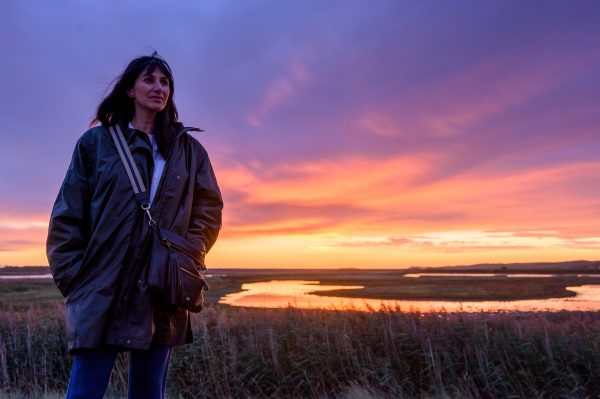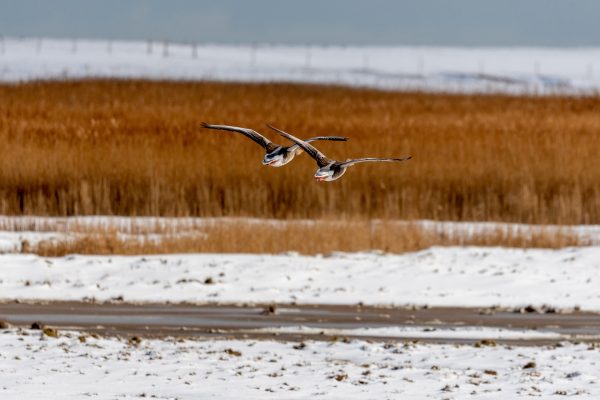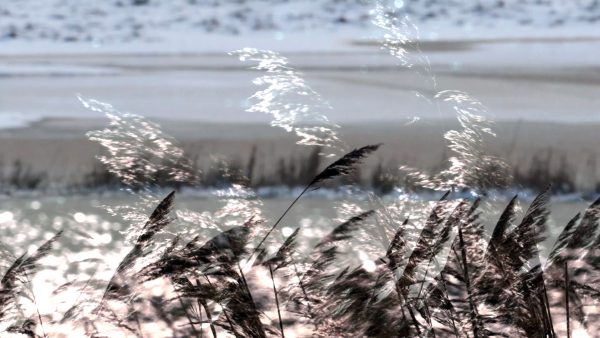Waking up language(s); translating birdsong/poetic alchemy in Cley

It was Virginia Woolf who pointed out that the first lyric gesture was that of bird song. The sounds of birds are often the first non-human sounds we encounter as we step outside our thresholds as infants.
I am currently writer in residence at Cley Marshes an area supported by the Norfolk Wildlife Trust. My task is to respond to this unique landscape and generate new literary forms – in my case poems. Unusually for a residency the destination of the poems will be to settle into a digital space and installation.
Cley is a unique place and supports many migratory species and is part of the east Atlantic flyway. One surprising aspect for me about these wetlands is that Cley’s existence is so dependent on human hand and intervention in terms of how it is managed. Cley is important as it gives us an early window to imagine what the future might look like through the imperilled present.
I have been travelling to this area over the last year with my own story; I was born in the UK into a Sikh Punjabi family. I am second generation, brought up under the Heathrow skies in the 1970s, I am part of the Blue-Peter-watching, fish-finger-eating desi angst generation but entering the countryside was never part of my childhood. Nature invariably found itself into my work, most of my poems are vibrating with living things, insects, flowers, gardens, these were not invited visitors as such, but they stole themselves in like fugitive guests into the soil of the work. Birds in particular have featured in so many of my poems, hummingbirds and bulbuls and sparrows, but these creatures often stood in for something else or were estranging an experience – are these creaturely poems nature poems?

I was planning my first visit to Cley in May last year but the Covid Pandemic made this impossible, and so I was left to my own devices seeking out the birds of Cley online. As I leaned in to listen to the birds, I became slightly obsessed. There is a very human impulse to render the sounds into language. In fact, there is no culture on earth that does not attempt to do so. The poet John Clare’s transcription of the nightingale’s song has long been celebrated for his capturing, syllabising and transcribing the sounds of a nightingale.
When I encountered the birds of Cley I listened carefully to recordings of the birds, the lapwing, the godwit, the reed warblers. I slowed the recordings down and sped them up – if you slow down a reed warbler 50 percent it sounds like a fox but if you slow it down even further it sounds dinosaurian.
Transcribing bird song is an activity that has fallen out of fashion. I mean the old school way where writing hand and listening and the act of transcribing are all connected. It feels like a twee, quaint even over sentimentalised enterprise, seeing as we now have technology and sonographs and soundwaves to map and chart bird sounds. In addition, other artists might make the case that some animals are best understood by emphasising the musical rather than linguistic qualities. But doesn’t this simple act of listening and trying to vocalise bird song still have value? I think for the poet it does because the elemental task feels like a radical act in an age of uber technology and mobile phones. The simple activity does get us very close to the material of language, the granularity and peculiarity of it, the guts. Bird song can be incredibly complex in range and pattern or it can be simple cycles of repeated shrill song. Untethered from syntax, meaning and grammatical structure bring to bear something else in your listening. That surprising feature for me was a hyphenated form of listening, both in English and my first language Punjabi. This is not a language I write or think in even, but in recent years it’s been folded up and relegated to a small suitcase, a kind of residual back of my body language. When a lapwing utters her song, I suddenly hear ‘Kui’ ‘Kui’ translated as ‘why’ in Punjabi, when the Godwit proclaims ‘Thohreh Deh’ ‘Thohreh Deh’ it translates as ‘give me a little’ and you can see what I have done here – I am bouncing between the two language poles flitting from one to another. Why should bird song arouse a language that I seldom use in public and never employ in my writing? When I was in infant school, I kept using the word ‘balti’ for the word bucket at school during play time. My teachers constantly corrected me and finally explained the difference between my ‘home’ language and my ‘school’ language. I was embedded in the post-colonial education system that devalued the ‘mother tongue’ and was disinterested in its literature or culture. Since then, Punjabi has always been my deferred language, rarely used but in Cley feeling mildly estranged in an unfamiliar landscape provided an interesting indeterminate space to rediscover the language and to employ it in my writing.
In the end using two separate languages will not get you any closer to sense-making. That is not the point. The point is to be fascinated and deeply connected with the song and sit on the edge of something so counter and strange it resists certainty. So much so that you must surrender to listening. In nature writing the word ‘wild’ is a contested concept because when we look about us what animal or fauna in the natural world is not tamed or tagged and rationalised? But bird song is ungovernable and is still beyond our reach as Kant noticed: “a bird’s song, which we can reduce to no musical role, seems to have more freedom in it, and thus to be richer for taste, than the human voice singing in accordance with all the rules that the art of music prescribes”. Listening to bird song moves us into the realm of the sublime. This domain of unsettledness and ambiguity is also a space for where our imaginations are most alive, as the French philosopher Gaston Bachelard elucidates in the ‘Poetics of Reverie’. It’s a place to incubate an idea blanketed in the shimmering consciousness and a rare place of unthinking thinking.
If I’m listening to bird song in Covid times it seems that everyone else is too; the RSPB states that there’s been a 69 percent increase in website users compared to the same period last year.
At Cley nature reserve a single raised path separates the salt marshes from the freshwater wetlands, and the shifting sounds of the Norfolk reed. When you begin the walk by the visitor’s centre the traffic from the road fills your ears. Then, as you begin to enter the marshes this recedes to be replaced by the sound of the reeds. Everyone tells you about the big Norfolk skies but in this place the big sky is like a giant dynamic canvas. In your peripheral vision a flicker of a tail wing disturbs your eye, in your central vision a flinty white object is thrown into relief against the blue. Then there are the sounds of Cley as you lose the noise of the road to gently tune in; the reeds hush over you and the reed warblers twitch as you push forwards trying to capture it all. Soon enough you find yourself at the other end, standing on the shingle beach in front of the churning dark waters of the North Sea. When I last visited it was September, a real time of transition. Many migratory birds had already gone and those wintering in Cley were arriving. We spotted geese, the pink-footed kind, arriving from Iceland announcing their arrival. We saw the common graylag but then unexpectedly a kestrel and red shanks. The salt marshes were now lit with samphire but when I’d last visited in July it was sea-lavender.

Looking out to the North Sea, I inevitably reflect on how a diasporic writer can get caught up in a vast skein of paradoxes, and how this inflects my poems responding to the British landscape. I have always felt safe in cities. My father grew up Amritsar close to the partition line between India and Pakistan. The state of Punjab is often referred to as the green heart of India but since my father left those fields and arrived in the UK, he has rarely travelled to the countryside. I’ve been thinking a lot about the consequences of up-rootedness where so much human migration is an urban experience, and like the birds I’m recording, we flock to zones of comfort, in language, culture and safety.
I probe this question – what qualifies as a nature poem? Who is seen and not seen as a nature writer and why? And that despite my urban dwellings I have never NOT considered myself a nature poet. Across the Atlantic in the United States there have already been attempts to expand the horizons around nature poetry to include broader discussions around race and the personal, while looking at the relationship between the violence of climate change along with the de- humanising of migrants and the tenacity and violence of racism.
The US poet Lucille Clifton famously writes in ‘Other Poem’ but whenever I begin “the trees wave their knotted branches and… why is there under that poem always another poem?” Black and Asian nature poetry is being written but all too often writers of colour are read against identity at the expense of other themes and preoccupations. Writers of colour have a complicated relationship with landscape. Publishers and anthologies have often narrowly represented poets and often failed to understand what contemporary nature writing can be or question why concerns around race and politics are left out of the space. Reimagining this space and engaging purposefully with these issues can lead to some provocative but exciting work and enrich the literary landscape for us all.
Standing on that beach at Cley in the ever-shifting painterly landscape, you notice how sensitive this part of the world is. You also realise how interconnected you are from the Arctic to Africa, that Cley is a small and fragile chink in the chain of the East Atlantic flyway – you can’t help but feel small. The last time at Cley I visited with field recordist Peter Cusack who was capturing the world of Cley in sound. We discussed how the poems I was writing would live. I wanted to write about life on Cley, the birds, flora, reeds, insects but it felt so vital for the poems to exist wrapped in the sounds of this vanishing landscape. I told him I was writing a poem for the humans who, like it or not, were a physical presence in Cley. The poetic project is part of a larger conversation around the future of writing forms which include script writers and novelists. One of my greatest fears was that lyric poetry might not be able to withstand being handled in a digital space. What would happen to the delicate material of its structure and integrity? Might it disappear entirely? In the end it’s that indeterminacy that was lit and illuminated by digital engagement which was gently explored so that the sounds and images of the landscape and the work itself has been reimagined into new literary forms. Some of the Cley poems are embedded into the shingle and near bird-hides and the poems open like a digital envelope for visitors passing. Peter suggested taking a recording of our footsteps climbing up the shingle slope down from sea and wrapping the poem in our soft and unsteady footsteps. Sounds. Inside, the poems’ Punjabi words and lapwing calls and the English lyric lines braid together to create hybrid composition, and I realise now that this project is really a translation projection rendering a true symphonic journey. Anthropologist Eduardo Kohn uses the term ‘decolonising thought’ for the process by which we become interlaced with the natural world which then leads to a shift in perception. This is the vantage point we need. Entangling ourselves with our languages can lead to some unexpected and sublime results if we let them.
Mona Arshi, 2021